New perk! Get after it with local recommendations just for you. Discover nearby events, routes out your door, and hidden gems when you sign up for the Local Running Drop.
While many gyms across the country (and world) may not be open yet, even once they do, the thought of using that well-loved equipment may be just enough to make you skip your strength training routine. The worst thing about taking a pass at that weight workout is that you may need it now more than ever. The good news is the best at-home strength training equipment is cheaper, smaller, and more creative than ever—especially when it comes to the kind of workouts that triathletes should be doing. While you won’t necessarily be able to powerlift from the comfort of your home with a giant squat rack, you could always strap up your car to your body and tow it uphill (just kidding, please don’t do that).
Before we get into out favorite at-home strength training equipment, a few tips on what to look for when you buy (and why):
Why Should I Set Up A Gym At Home?
Quarantine/coronavirus fears aside, if you have a solid strength training setup at home, you’ll be far more likely to actually do the routine you know you should. In fact, some (but definitely not all) workouts are best performed immediately after your bike or run—something that’s nearly impossible to do in many gym situations. Even if you don’t do it for convenience’s sake, having a gym at home is a great idea if you don’t have an in-person coach or personal trainer, like most of us, because you can fire up YouTube videos of people you trust and vet who will guide you through the motions. Add in a mirror and a quick YouTube refresher from time to time, and you’ll be sure that you’re doing the movements correctly, rather than rushing through and/or trying to just heap on as much weight as you can just to flex on the other gymgoers.
What Should I Look For In At-Home Strength Training Equipment?
Even if you’re not interested in the hand-selected gear below, there are a few things you should look for when shopping around. First, try to find something that doesn’t take up a lot of space. Even if you don’t live in a tiny apartment, the big benefit to getting at home strength training equipment that has a small footprint is that you can usually take it with you wherever you need to go. That can mean bringing your gear on a work trip, when you’re on vacation, maybe even when you’re traveling to a race to help with training consistency. Getting tired of doing your TRX routine in the garage? Ride out to a park and set it up on a strong tree limb! Make that hippy with the slackline setup eye you in the same way you eye him.
Also be sure it’s versatile: Triathletes do a lot more movement than the normal endurance athlete, so our strength training programs should reflect that. Not only should we be doing dynamic and varied movements when we strength train, but it’s very likely that our strength training program could change from month to month or season to season—based on what we’re focusing on or dealing with during that time.
Without further ado, let’s take a look at our top five picks for the best at-home strength training equipment:
Best At-Home Strength Training Equipment With Actual Weight
Empack 2.0
$134, Theempack.com
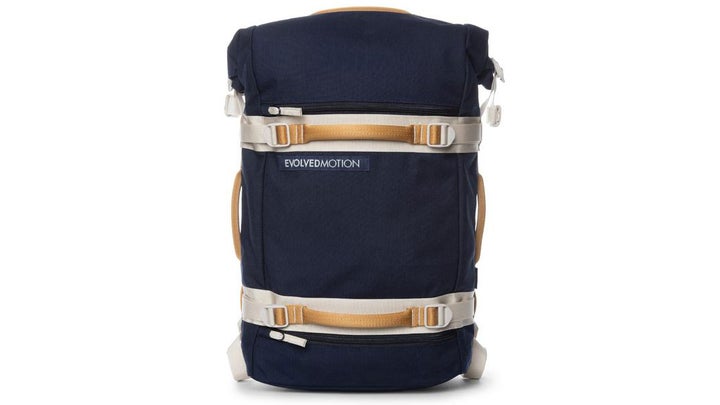
So before you read any further, know that this is NOT intended as a weight vest. While you can fill the bag with weight and wear it with the included backpack straps, that’s not the main function—in fact it’s not remotely the best use of this bag. Rather, the idea behind this bag is that you can use it as a standard roll top bag with pockets, laptop access, and even a hydration sleeve, OR you can fill it with included bladders (the 2.0 comes with two reservoirs but can fit four) and use any combination of the six padded, but structured, handles to perform any number of weighted workout movements. Each bladder can be filled with up to 15 pounds of water or 21 pounds of sand, and with the super strong and sturdy cinch straps, you can put in one bladder with water for roughly 17 pounds of weight, up to a max of 85ish pounds of weight with four bladders full of sand. The Cordura construction is super tough, and they’re all designed in Colorado, so you can know you’re buying from actual athletes, not just some random factory in China. The variety of workouts you can do is basically limited by your imagination (YouTube “sandbag workouts” for literally thousands), and the fact that it’s a backpack means you can take it when you travel or train remotely.
Best At-Home Strength Training Equipment For Wicked Core Work
SKLZ Corewheels
$30, Amazon.com
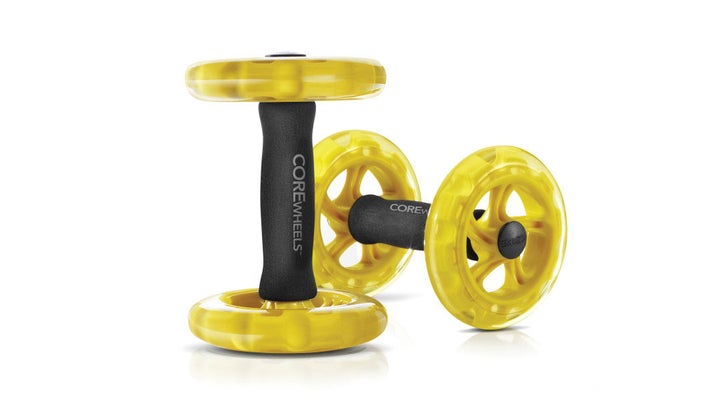
Though they may seem simple and innocuous, these well-made wheels can become instruments of core torture when wielded properly. Using super tacky wheels that look like they belong on some sort of oversized pair of Rollerblades, this setup has far more options for movement than a standard ab roller (which is still a great tool, by the way). You can use them asymmetrically, on an incline or decline, or even on a wall when first trying to build arm/core strength. In fact, you can even hook your ankles on the handle and use them for leg work if you feel inspired. The soft foam handles provide a good amount of grip and enough cushion to prevent you from giving up due to hand soreness before your core hits the wall. An included manual gives a good assortment of workout options, but again, with a little creativity and some YouTube time, the variations are endless.
Best At-Home Strength Training Equipment For Burnin’ Buns
Recredo Booty Bands
$43, Amazon.com
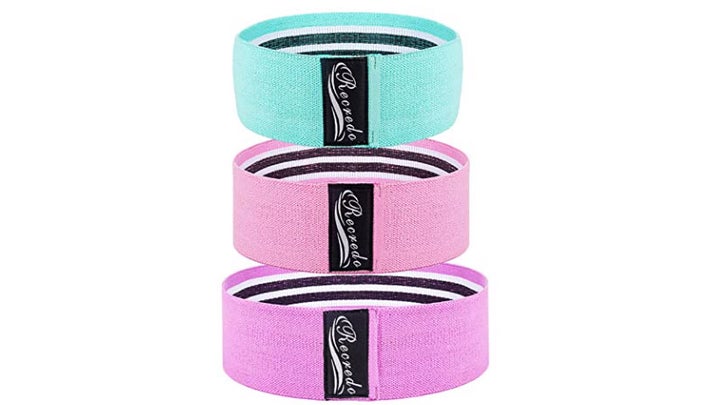
Ok, bear with us on this one. Yes, we understand not too many triathletes work out with the sole intention of getting a booty that just won’t quit, but there are actually fantastic exercises that triathletes need to be doing with this piece of simple equipment—think of them as long-lasting and more versatile Thera-Bands. With the Booty Band (I can’t even type it without chuckling), you can do a host of absolutely essential hip and stabilizer muscle movements—something that EVERY triathlete should be doing to prevent injury. From simple motions like side-to-side crab walks to more advanced moves like gluteal bridge clamshells, endurance athletes should absolutely make these a part of their routine to prevent all sorts of upper- and lower-leg injuries generated from weak hips and glutes. Not only for hip work, these long-lasting bands can also be employed for upper body work when anchored properly.
Best At-Home Strength Training Equipment For Doing It All
TRX Pro4
$250, Trxtraining.com
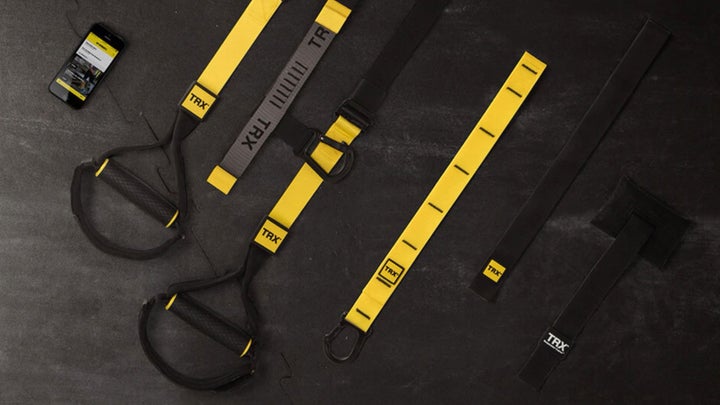
If you haven’t heard of TRX yet, you may be living under a quarantined rock—but we’ll still forgive you. Using nothing more than super burly nylon straps, a strong anchor point, and some creative handles, this product may have looked like a fad at first, but it has stuck around for one big reason: It works. More pro coaches than I can count use this with their athletes because it takes up very little space but works almost every part of your triathlete person via creative angles, heights, positions, and body weight. You can do workouts that will absolutely destroy your core or you can do workouts that gently rehab an injury. The most important keys to using a TRX are finding a safe place to anchor the top (remember that tree branch?) and paying very close attention to the exercise instructions so you don’t accidentally hurt yourself or get nothing out of the session because you’re doing it slightly wrong. Much like the last thing on our list, the TRX is highly dynamic, so you’ll be working out muscles you didn’t even know you had.
Best At-Home Strength Training Equipment For Working The Details
Bosu Home Gym Bundle
$200, Bosu.com
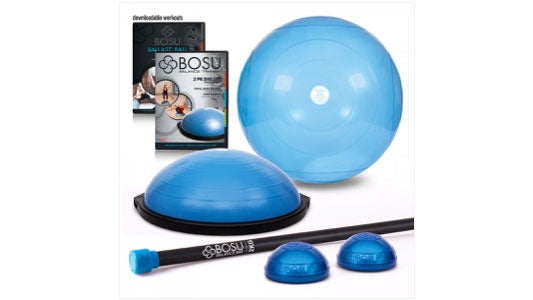
You may have seen Bosu balls at the gym or at a physical therapists’ offices if you’ve even been “unlucky” enough to have to visit one, but these simple toy-looking tools are anything but. While you could conceivably use this bundle to hit most of the major muscle groups you need to as a triathlete, it’s actually the little muscles that’ll get the most benefit. By using a highly dynamic (that’s something that causes a lot of movement) design, Bosu equipment helps work on your stability—for both upper and lower body—something triathletes need help with badly. In other words, the tiny little muscles that you use to help balance you on the balls and half balls (the bundle also comes with a helpful weight bar) become activated and strengthened, which will make you either way less prone to injury or help you rehab any imbalance-related injuries you already have. You can even use the balls in conjunction with literally any of the other four options on this list for an enhanced workout. There’s a reason professional physical therapists use this stuff—if you get your own, you may never even have to visit one.
